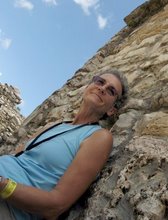
This time, my post is not about my dissertation work or about ancient Palenque, but rather about a temporary setback I am experiencing due to an unfortunate miscalculation I made while trying to keep some newborn kitties from getting soaked from an approaching rainstorm. It happened the afternoon of July 10th at the house where I am staying in the town of Palenque, Mexico.

Mommy kitty had given birth in an outside corner of the house. There is a small overhang above, but there are very strong winds that blow through here, so I decided to go upstairs to the flat roof above to see what I could do to protect them. This is a top view of the corner.

On the roof, I saw some sheet metal that I could simply move over a few feet so that it would overhang the corner and add protection (the sheet metal has now been moved back to the other side). Somehow, as I was doing this, I lost track of where the edge of the roof was located. If I had been standing, I would have noticed the location of the wooden railing that goes along the edge, but I was in a squatting position the whole time, as I moved the sheet metal over.

I then stepped on a portion of the sheet metal that was not stable and went tumbling down.

The distance I fell measures about 4 or 5 meters.

This is where I landed.
 This picture of my wounded self was taken July 15th - 5 days after the accident. One wrist has pins in it and the other is in a cast. I looked pretty bad, but I am healing very well now and I continue to receive lots of prayers and assistance from loved ones and friends. Hey, I can even blog now! Life is good.
This picture of my wounded self was taken July 15th - 5 days after the accident. One wrist has pins in it and the other is in a cast. I looked pretty bad, but I am healing very well now and I continue to receive lots of prayers and assistance from loved ones and friends. Hey, I can even blog now! Life is good.

Soon after the Mexican Red Cross ambulance took me on the harrowing two-hour ride to the hospital in Villahermosa, mommy kitty moved her brood into the kitchen cabinet, next to the stove. All safe and sound now. Aren't they cute?
 In at least two of the INAH Anales reports regarding Palenque, Alberto Ruz thanked Nelson Rockefeller for the funding he contributed to the excavation projects at the site. When I read this statement, it sparked my curiosity, so I contacted the Rockefeller Foundation archives to see what I could discover about it. They sent me copies of several pieces of correspondence (1947- 1958) between Ruz, Rockefeller and the members of the Institute of Andean Research. This institute was the organization through which Rockefeller funneled the money - apparently for political reasons. Above is a picture of Rockefeller on the cover of Life magazine when Life did a story on the Museum of Primitive Art.
In at least two of the INAH Anales reports regarding Palenque, Alberto Ruz thanked Nelson Rockefeller for the funding he contributed to the excavation projects at the site. When I read this statement, it sparked my curiosity, so I contacted the Rockefeller Foundation archives to see what I could discover about it. They sent me copies of several pieces of correspondence (1947- 1958) between Ruz, Rockefeller and the members of the Institute of Andean Research. This institute was the organization through which Rockefeller funneled the money - apparently for political reasons. Above is a picture of Rockefeller on the cover of Life magazine when Life did a story on the Museum of Primitive Art.  Above is a picture of Alberto Ruz. One of the stipulations regarding the receipt of the Rockefeller funds was that they were to go hand-in-hand with the money that the Mexican government was putting into the project. In 1955, Rockefeller requested a summary of all the funds contributed by INAH as compared to his. According to Ruz' accounting, between 1947 and 1955, Rockefeller had contributed 40% of the entire budget for the project, with INAH putting in 60%. From the tone of the correspondence between these two great men, it is possible to see that they were very warm friends. Time and time again, Ruz invited the Rockefellers to Palenque and finally they did make one visit. Ruz wrote in 1956 "My wife and I have the fondest remembrances of yours and Mrs. Rockefeller's brief stay among us." He was referencing Rockefeller's first wife, Mary Todhunter Clark, who also would eventually contribute money to the project.
Above is a picture of Alberto Ruz. One of the stipulations regarding the receipt of the Rockefeller funds was that they were to go hand-in-hand with the money that the Mexican government was putting into the project. In 1955, Rockefeller requested a summary of all the funds contributed by INAH as compared to his. According to Ruz' accounting, between 1947 and 1955, Rockefeller had contributed 40% of the entire budget for the project, with INAH putting in 60%. From the tone of the correspondence between these two great men, it is possible to see that they were very warm friends. Time and time again, Ruz invited the Rockefellers to Palenque and finally they did make one visit. Ruz wrote in 1956 "My wife and I have the fondest remembrances of yours and Mrs. Rockefeller's brief stay among us." He was referencing Rockefeller's first wife, Mary Todhunter Clark, who also would eventually contribute money to the project.





























